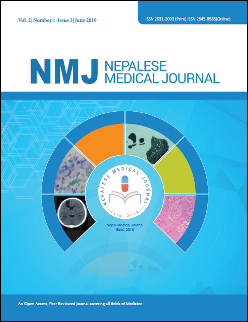Ocular Presentations in High Altitude Sickness: Experience of Our Centre
DOI:
https://doi.org/10.3126/nmj.v2i1.23996Keywords:
Retinal hemorrhages, high altitude retinopathy, High altitude cerebral oedema, High altitude pulmonary edema, RetinopathyAbstract
Introduction: High altitude has various effects on human beings. Altitude-related illnesses are a frequent cause of morbidity and occasional mortality in travelers to high altitudes throughout the world. Altitude has potential undesired ophthalmological effects too. Most of these problems are primarily preventable with an adequate level of information before and during travel. In this article, ophthalmological effects like altitude retinopathy and other ocular presentations of high altitude, likely to be encountered by mountaineers, are reviewed.
Materials and methods: This is a hospital-based cross-sectional study from March 2016 to March 2017 done in Swacon International Hospital and Sleep Care Center, Kathmandu, Nepal. All the patients diagnosed as acute mountain sickness in the hospital during the study period were included. All the patients were evaluated by a physician and an ophthalmologist. All the findings were recorded in the proforma.
Results: A total of 167 patients were admitted. Among them, 98 patients were diagnosed with acute mountain sickness; 20 patients had High altitude cerebral edema and 40 had High altitude pulmonary edema. Ocular findings, among patients who presented to our centre, were a high altitude retinopathy (28.48%) corneal abrasions (5.6%), snow blindness (8.86%), acetazolamide induced myopia (2.53%), conjunctivitis(8.22%), corneal ulcer (1.26%) and retinal detachment(0.63%).
Conclusions: Mountaineers are at risk of developing high-altitude-related illnesses. Many other tissues in the eyes are also affected by high-altitude hypoxia, and effects can be observed on the conjunctiva, cornea, intraocular pressure, lens, uvea apart from the retina and the optic nerve.
Downloads
Downloads
Published
How to Cite
Issue
Section
License
This license enables reusers to distribute, remix, adapt, and build upon the material in any medium or format, so long as attribution is given to the creator. The license allows for commercial use.
Copyright on any article published by Nepalese Medical Journal is retained by the author(s).
Authors grant Nepalese Medical Journal a license to publish the article and identify itself as the original publisher.
Authors also grant any third party the right to use the article freely as long as its integrity is maintained and its original authors, citation details and publisher are identified.




